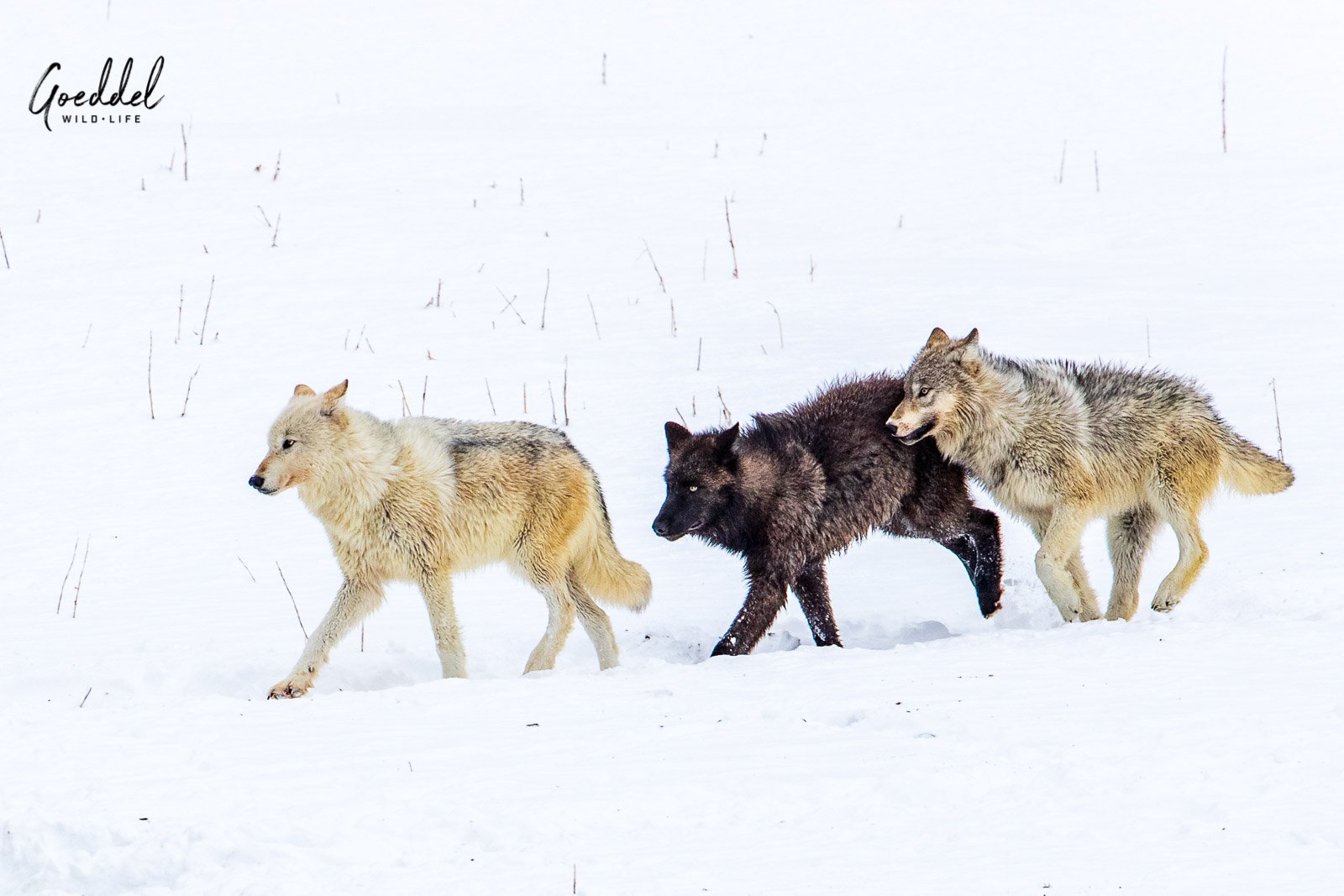A step in the right direction: Montana Fish and Wildlife Commission reinstates wolf hunting and trapping quotas north of Yellowstone
The successful reintroduction of wolves to Yellowstone National Park is a tremendous conservation success story that has been celebrated around the world. Yellowstone’s wolves are iconic, and people of all walks travel to our region to see these inspiring animals in the wild. Since Montana wolves were delisted from the Endangered Species Act in 2011, hunting and trapping quotas have been in place for the lands immediately north of Yellowstone. These low quotas were intended to protect Yellowstone wolves that might venture out of the park into Montana. Until last year, the quotas ranged from two to four wolves in Wolf Management Units (WMUs) 313 and 316—those bordering the park to the north—and limited wolf mortality on the park boundary.
Wolves in Yellowstone National Park. (Photo GoeddelGallery.com)
Despite the success of this approach, last year the Montana Fish and Wildlife Commission eliminated wolf hunting and trapping quotas from the units just north of Yellowstone. This resulted in 21 wolves taken from the units just across the park boundary, which make up less than four percent of the land base in all of Southwest Montana.
Following the last wolf hunting and trapping season, the Greater Yellowstone Coalition worked with numerous partners to advocate for a return to a quota of one wolf in each unit bordering Yellowstone. This strategy of low quotas in units adjacent to the park worked for a decade as a compromise between wolf hunters and trappers, wildlife viewers, and the locals whose livelihoods depend on wildlife tourism. Over the last six months, we have worked hard to ensure Montana Fish and Wildlife commissioners consider their responsibility to represent the interests of all Montanans. We emphasized that returning to a quota of two wolves across the two hunting units is a simple solution to provide some relief to locals and protect thousands of rural jobs.
Yesterday, the Montana Fish and Wildlife Commission met to make a final decision on the 2022/2023 wolf hunting and trapping season structure proposed by Montana Fish, Wildlife & Parks this summer. The commission voted unanimously to combine the two units adjacent to Yellowstone National Park into one (313) and set a quota of six wolves for that area. Additionally, they implemented region-wide harvest thresholds that will trigger automatic hunting and trapping closures for the remainder of the season. This is a solid step in the right direction and good news for Yellowstone wolves. We are appreciative of the commission for listening to the concerns of Montanans around wolf hunting and trapping just outside Yellowstone National Park. We look forward to ongoing dialogue with the commission regarding the negative impacts of aggressive wolf harvest just across the park boundary.
The Wapiti Pack in Yellowstone National Park.
In future decision-making around wolf hunting and trapping in Montana, we will continue to elevate the following considerations:
Wolves are valuable to local economies in Montana. Wolf watchers bring $82 million to communities in the Greater Yellowstone Ecosystem, many of which are in Montana. In Park County alone, tourism supports 3,270 Montana jobs.
Wolf hunting in WMU 313 is not a legislative requirement for managing the statewide wolf population. This area has not been identified as an area of interest in recent legislation related to wolves. There is no legal mandate for a high quota here.
There is no scientific rationale for aggressive wolf harvest in WMU 313. Livestock depredations attributable to wolves have not been documented in the area. Additionally, the elk herd that uses WMU 313 has been at or above population objectives set by Montana Fish, Wildlife & Parks since wolves were reintroduced to Yellowstone.
Aggressive wolf management is not the solution to enhancing ungulate hunting opportunities in Montana. Research shows that first and foremost, elk and other ungulate species need quality habitat. Killing more wolves is not a scientifically backed solution to improving elk hunting opportunities, and in fact, wolves play a critical ecological role in keeping ecosystems healthy.
We understand that a quota of six will still feel too high to many of the folks whose livelihoods depend on Yellowstone wolves, and we encourage you to stay involved moving forward. Thanks to the engagement of Yellowstone National Park, advocacy of the local business community, and the voices of people like you the commission has taken a step in the right direction for Yellowstone wolves.
Thank you for speaking up for Greater Yellowstone’s iconic wildlife.
—Brooke Shifrin, Wildlife Conservation Coordinator
The Greater Yellowstone Ecosystem is the land of 49+ Indigenous Tribes who maintain current and ancestral connections to the lands, waters, wildlife, plants, and more.



